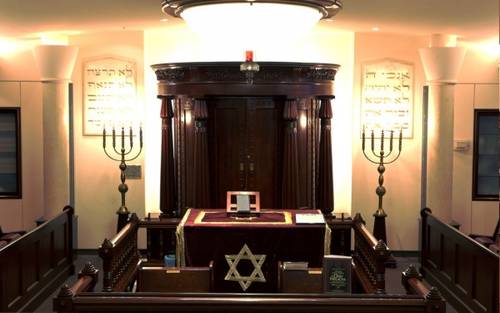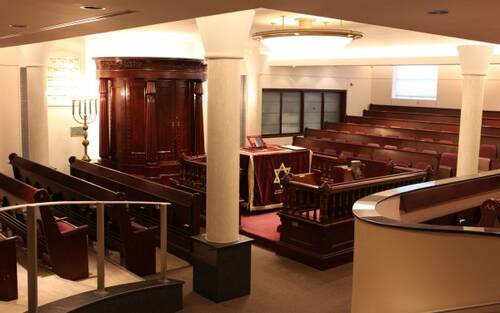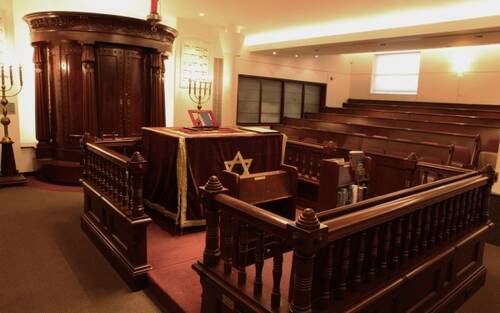CHABBAT TEROUMA / 9 FEVRIER 2019/ 4 ADAR 1 5779
PETIHAT HAHEKHAL : SOLOMON SASSON
NOUVEAU PROGRAMME :
Nous invitons tous nos membres et amis à nous transmettre les dates de décès des membres de leur famille, nous les enregistrerons , et 2 semaines avant la date, nous contacterons les familles et les invitons à se joindre à nous le Chabbat de la Hazkara. Nous leur réserverons une Aliya à la Torah, ils liront le Kaddish avec une Hachkava, et à la fin des prières ils se joindront à nous pour le Kiddoush , un des plus beaux et plus complets de Montréal.
Si vous n’avez pas la date hébraique, donnez nous la date grégorienne et nous la convertirons.
A cette occasion vous pouvez offrir ou participer au Kiddouch à la mémoire du défunt.
Ce programme s’adresse aussi aux jeunes qui ont fait la Bar-Mitzvah chez nous ou ailleurs et qui aimeraient lire la portion de Torah qu’ils ont apprise. Un cadeau leur sera offert..
Pour nous contacter afin de nous donner les détails, soit que vous répondez à ce message ou vous allez à
macommunauté@maghenabraham.com
LA PARACHA EN BREF:
Il est demandé au peuple d’Israël de faire don de 15 matériaux – or, argent, cuivre ; laine teinte de bleu, de pourpre et de rouge ; lin, poils de chèvre, peaux d’animaux, bois, huile d’olive, épices et gemmes – desquels D.ieu dit à Moïse « Ils Me feront un sanctuaire et Je résiderai parmi eux. »
Au sommet du mont Sinaï, Moïse reçoit des instructions détaillées sur la façon de construire cette demeure pour D.ieu afin qu’elle puisse être facilement démontée, transportée et réassemblée lors du voyage du peuple dans le désert.
Dans la pièce la plus intérieure du sanctuaire, derrière un rideau artistiquement tressé, se trouvait l’arche contenant les tables du témoignage sur lesquelles étaient gravés les Dix Commandements ; sur le couvercle de l’arche, se tenaient deux chérubins ailés, taillés dans un bloc d’or pur. Dans la pièce extérieure se dressait la Ménorah à sept branches et la table sur laquelle les « pains de proposition » étaient disposés.
Les trois murs du sanctuaire étaient composés de l’assemblage de 48 planches de bois qui étaient chacune recouverte d’or et tenue par une paire de socles en argent. Le toit était constitué de trois couches de couvertures : a. des tapisseries multicolores de laine et de lin, b. une couverture de poil de chèvre, c. une couverture en peau de bélier et de ta’hach. Face à l’entrée du sanctuaire, une tenture brodée était tenue par cinq poteaux.
7 ADAR : DAY OF BIRTH AND DAY OF DEATH OF MOSHE
Yahrtzeit of Moses in 1273 BCE (Jewish year 2488), on the same day of his birth 120 years earlier. (Consequently, "May you live to 120" has become a common Jewish blessing.) Moses was born in Egypt at a time when Pharaoh had decreed that all Jewish baby boys be drowned in the Nile River. His mother set him afloat in a reed basket, where he was -- most ironically -- discovered by Pharaoh's daughter and brought to Pharaoh's palace to be raised. When Moses matured, his heart turned to aid the Jewish people; he killed an Egyptian who was beating a Jew, and he fled to Midian where he married and had two sons. God spoke to Moses at the Burning Bush, instructing him to return to Egypt and persuade Pharaoh to "let My people go." Moses led the Jews through the ten plagues, the Exodus, and the splitting of the Red Sea. Seven weeks later, the Jews arrived at Mount Sinai and received the Torah, the only time in human history that an entire nation experienced Divine revelation. Over the next 40 years, Moses led the Jews through wanderings in the desert, and supervised construction of the Tabernacle. Moses died before being allowed to enter the promised Land of Israel. He is regarded as the greatest prophet of all time.
Les Treize Principes de la foi juive s’énoncent comme suit :
1. La croyance en l’existence du Créateur, qui est parfait dans toutes les modes d’existence et est la Cause Première à tout ce qui existe.
2. La croyance en l’unité absolue et sans égale de D.ieu.
3. La croyance en la non-corporalité de D.ieu, ni qu’Il peut être affecté par tout événement matériel, tel que le mouvement, le repos ou la résidence.
4. La croyance en l’éternité de D.ieu.
5. La croyance en l’impératif d’adorer D.ieu exclusivement et de n’adresser de prière à aucune fausse divinité.
6. La croyance que D.ieu communique avec l’homme à travers la prophétie.
7. La croyance en la primauté de la prophétie de notre maître Moïse.
8. La croyance en l’origine divine de la Torah.
9. La croyance en l’immuabilité de la Torah.
10. La croyance en l’omniscience et la providence de D.ieu.
11. La croyance en la récompense et le châtiment divins en fonction des actes de l’homme.
12. La croyance en l’avènement du Machia’h, le Messie, et de l’ère messianique.
13. La croyance en la résurrection des morts.
Il est de coutume dans de nombreuses communautés de réciter les Treize Principes, dans une forme légèrement plus poétique, commençant par les mots Ani Maamine – « Je crois » – chaque jour après les prières du matin à la synagogue.
Le vendredi soir, après l’office de l’entrée du Chabbat, le poème Yigdal qui retrace les Treize Principes de Foi est chanté dans de nombreuses communautés.
A lion on the Parochet?
In the Mishkan there were embroidered tapestries. This week in Shemot 26:1 we read
that there were 10 curtains made of fine twined linen, and blue, and purple, and scarlet threads,
with cherubim on them. Rashi adds that on one side was sewn a picture of a lion and on the
other side of the cloth a picture of an eagle. The question is how is that possible. We know that
God commanded us not to make any images other than the images expressly dictated in the
Torah such as the Cherubim. Is it permissible to have a curtain with a lion sewn on it? Today
many Ashkenaz synagogues will have a lion on the Parochet, curtain in front of the hechal in the
Synagogue and some will saw lions onto the Tefillin bag as well.
Rabbi Ovadia Yosef addresses this question in one of his books, Yehave Da’at 3:62.
There he writes that Rabbi Yosef Karo stated that technically only protruding full images of a
human face are prohibited but that he still discouraged having pictures of birds or other animals
drawn on the wall or on the stained glass windows of a synagogue where people are praying.
Rabbi Karo writes that one who is God fearing should protest vehemently until the images are
removed. Rabbi Yosef adds that rabbis all over the world should teach their congregants and
those that make the curtains that this it is forbidden to make these curtains and hang them in
the synagogue. One concern is that it distracts those praying and in addition it may appear as
they are bowing and praying toward these lions or other animals. Rabbi Messas in his book
Mayim Hayim writes how his father was once angered over the community hanging curtains
with pictures of birds and other animals on it in the synagogue. He had them take it down
immediately. Some synagogues will have pictures of animals representing the sons of Jacob
and the tribes. This would pose the same issue. Former Chief rabbi Ya’akov Meir lived from
1856-1939 and was the first Sephardic Chief rabbi under the British mandate. He too writes
against having pictures of animals anywhere in the synagogue.
It seems to have been more accepted in the Ashkenaz lands and maybe this is why
Rashi felt it would have been ok if they sewed animals onto the parochet in the Mishkan. We
know however that even in the Mishkan/Mikdash we can not have any items that are not
explicitly commanded by God. As an example we are taught that the Torah writes that there
should be two cherubim. If someone made 4 cherubim the extra 2 would be considered full-
fledged idol worship in the Temple. We must only do what God commanded and not more. In
our synagogues today all the more so that we should eradicate all pictures of animals from
windows, paintings, curtains, tefillin bags, etc.
Teruma Quiz
1)Q. The skin of which now-extinct animal was used in making the Mishkan?
A. The Tachash. Tradition teaches that it was a beautiful multi-colored animal that only existed
at that time and then became extinct. Others teach that it was a sea animal. Rabbi Slifkin (zoo
rabbi) suggests it was a beaded tapestry and not an animal at all.
3)Q. Describe two uses of each of the following: a) oil; b) spices; c) jewels.
A. a) The oil was burned in the Menorah and used for anointing. b) The spices were a
component of the anointing oil and of the incense. c) The jewels were used in the Ephod and
the Hoshen (worn by the Kohen Gadol).
4)Q. Betzalel made the Aron out of three boxes, one inside of the other. Of what material were
these boxes made?
A. The middle box was made of wood and the outer and inner boxes were made of gold. (old
fashioned gold plating)
5)Q. How did Betzalel make the Cherubim?
A. They were hammered out of a solid block of gold as part of the cover of the Aron. They were
not made separately and added later.
6)Q. How did Moshe know the shape of the Menorah and how was the Menorah made?
A. According to the midrash, Hashem showed Moshe a Menorah made out of fire. It was initially
to be hammered from one block of gold, but when Hashem saw that it was very difficult for
Moshe, he told him that it should be thrown into the fire and it would come out completed by
itself.
7)Q. What was the length and width of the Mishkan?
A. 30 Amot (15 meters) long and 10 Amot (5 meters) wide.
8)Q. What were the dimensions of the Courtyard of the Mishkan?
A. One hundred Amot (150 feet) long by fifty Amot (75 feet) wide (about the size of large
homes / properties in Brooklyn).
9)Q. “Let them take for Me an offering.” (25:2) When the people were asked to give donations
to the building of the Mishkan, why does it not say “Veyitnu”—“and they should give”?
A. When a Jew gives Tzedaka (charity) he is not only giving but also receiving, because when
the poor man accepts the Tzedaka, the giver receives a Zechut (merit) for the mitzvah, through
which he will get back from Hashem ten times as much as he gave. On the words “Aser
Te’aser”—“You shall give a tithe,” (Devarim 14:22) the Gemara (Ta’anit 9a) says, “Aser Bishvil
shetit-Asher” By giving ten percent to Tzedaka, you will become rich.” Thus, by giving for the
Mishkan, the Jews were “taking” from Hashem much more than they actually gave. It is not just
the actual “points” one gets in heaven for doing the act, but the act itself has a beneficial affect
on the person and will help transform the person toward becoming a better and more successful
PROVERBES
Qui n'est prêt aujourd'hui le sera moins demain.
L'ordre et la liberté ne vont pas l'un sans l'autre.
Tôt ou tard on ressemble à celui que l'on aime
Il vaut mieux qu'un discours soit trop court que trop long
Les meilleures leçons sont celles qu'on se donne
Chacun a ses défauts, mais les nôtres sont derrière notre dos, nous ne les voyons pas.
L'amitié est une passion qu'on ne peut acheter à prix d'argent
Sème dès ton enfance, tu recueilleras de doux fruits dans ta vieillesse.
Maîtrise tes passions, si tu ne veux en être l'esclave.
Il ne faut jamais se décourager, le succès vient à l'improviste
LE SOURIRE DU CHABBAT
Un voleur s'était introduit de nuit chez Réuben et tout mis sans dessus dessous pour trouver quelque chose à voler. Soudain , il entendit un rire bruyant
C'était Réuben qui se moquait de lui, lançant:
- Idiot, tu viens chercher chez moi de l'argent dans l'obscurité alors que je n'arrive pas à en trouver quand il fait jour.
Un Juif qui louche rencontre un collègue qui lui demande:
-Salut, Mardochée, comment vont les affaires aujourd'hui?
-Comme tu vois
Un clochard dit à une passante, une dame très distinguée:
"la charité ,madame je n'ai rien mangé depuis deux jours"
"Oh mon Dieu..... si seulement j'avais votre volonté"
Un jour que son mari est en retard pour rentrer du travail, son épouse est très nerveuse et en parle à sa mère au téléphone:
" Je suis sûre qu'il voit une autre femme! "
" Pourquoi toujours voir le pire? Peut-être a-t-il simplement eu un accident. et il est à l’hôpital
CHABBAT CHALOM
MAGHEN ABRAHAM
David Hasson







